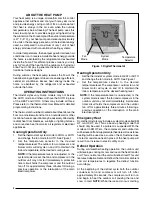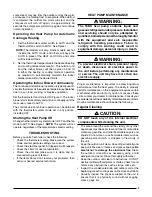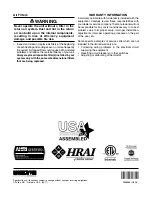
2
figure 1. Digital Thermostat
Fan
Mode
Temperature
Selector
System
Mode
aBoUT THE HEaT PUMP
Your heat pump is a unique, all weather comfort-control
appliance that will heat and cool your home year round
and provide energy saving comfort. It’s an unknown fact
that heat is always in the air, even when the outside
temperature is below freezing. The heat pump uses this
basic law of physics to provide energy saving heat during
the winter months. For example, If the outdoor temperature
is 47° F (8° C), your heat pump can deliver approximately
3.5 units of heat energy per each unit of electrical energy
used, as compared to a maximum of only 1 unit of heat
energy produced with conventional heating systems.
In colder temperatures, the heat pump performs like an air
conditioner run in reverse. Available heat energy outside
the home is absorbed by the refrigerant and exhausted
inside the home. This efficient process means you only
pay for “moving” the heat from the outdoors to the indoor
area. You do not pay to generate the heat, as with more
traditional furnace designs.
During summer, the heat pump reverses the flow of the
heat-absorbing refrigerant to become an energy-efficient,
central air conditioner. Excess heat energy inside the
home is absorbed by the refrigerant and exhausted
outside the home.
oPERaTInG InSTRUCTIonS
Thermostat styles vary. Some models may not include
the AUTO mode and others will have the AUTO in place
of the HEAT and COOL. Others may include all three.
Please refer to the thermostat’s User Manual for detailed
programming instructions.
The thermostat should be mounted about 5 feet above the
floor on an inside wall and not on an outside wall or other
location where its operation may be adversely affected by
radiant heat from fireplaces, sunlight, or lighting fixtures,
and convective heat from warm air registers or electrical
appliances.
Cooling operation only
1. Set the thermostat’s system mode to COOL or AUTO
and change the fan mode to AUTO. See Figure 1
2. Set the temperature selector to the desired
temperature level. The outdoor fan, compressor, and
blower motor will all cycle on and off to maintain the
indoor temperature at the desired cooling level.
noTE:
If the temperature level is re-adjusted, or the
system mode is reset, the fan and compressor in the
outdoor unit may not start immediately. A protective
timer circuit holds the compressor and the outdoor
fan off for approximately three minutes following a
previous operation or the interruption of the main
electrical power.
Heating operation only
1. Set the thermostat’s system mode to HEAT or AUTO
and change the fan mode to AUTO. See Figure 1.
2. Set the temperature selector to the desired
temperature level. The compressor, outdoor fan, and
blower motor will cycle on and off to maintain the
indoor temperature at the desired heating level.
noTE:
If the temperature level is re-adjusted, or the
system mode is reset, the fan and compressor in the
outdoor unit may not start immediately. A protective
timer circuit holds the compressor and the outdoor
fan off for approximately three minutes following a
previous operation or the interruption of the main
electrical power.
Emergency Heat
Some thermostats may include a system mode called EM
HT or AUX HT, etc. This is a back-up heating mode that
should only be used if a problem is suspected. With the
mode set to EM HT, etc., the compressor and outdoor fan
will be locked off and supplemental heat (electric resistance
heating) will be used as a source of heat. Sustained use
of electric resistance heat in place of the heat pump will
result in an increase in electric utility costs.
Defrost operation
During cold weather heating operation, the outdoor unit
will develop a coating of snow and ice on the heat transfer
coil. This is normal and the unit will defrost itself. This unit
features Adaptive Demand Defrost that monitors ambient
and coil temperatures to regulate the defrost function
accordingly.
At the beginning of the defrost cycle, both the outdoor
condenser fan and compressor will turn off. After
approximately 30 seconds, the compressor will turn on
and begin to heat the outdoor coil causing the ice and
snow to melt.
noTE:
While the ice and snow is melting,






















